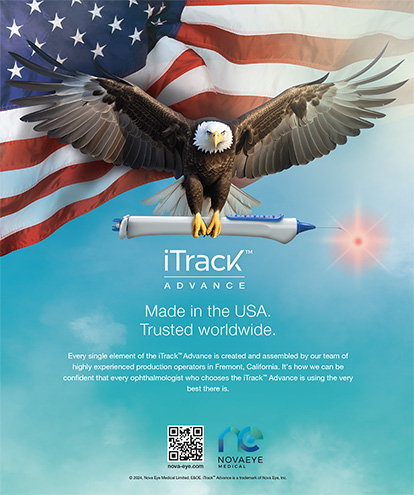CASE PRESENTATION
A 63-year-old white male presented to our office with a complaint that the vision in his left eye had decreased progressively over the last 5 years. Only limited historical information was available. He had undergone a bilateral, 16-incision RK for high myopia approximately 9 years earlier and had been content with his vision in both eyes until approximately 3 years prior to his consultation with us. As a result of the patient's progressive hyperopia, his ophthalmologist had prescribed topical 2% pilocarpine q.i.d. for the patient's left eye to stimulate miosis and induce a myopic shift. Eventually, the patient experienced cataract formation and complained of poor UCVA and BCVA in that eye.
Fourteen months previously, the patient had undergone cataract extraction in his left eye that involved the use of a pupil expander, which unfortunately had left him with a significant myopic refractive error. Because old records were unavailable, the surgeon had based his IOL calculations primarily on the contact lens overrefraction method. The surgery left the patient with a visually unacceptable myopic refractive error, and the patient subsequently underwent both an IOL exchange with a +21.50-D, 6.5-mm-optic 6741B IOL (Bausch & Lomb, Rochester, NY) and a YAG laser posterior capsulotomy.
The patient now complained of poor vision and monocular diplopia. He wore reading spectacles but had no distance correction. Our initial examination of his right eye revealed a UCVA of 20/30 and a manifest refraction of +0.50 +0.50 X 120 yielding 20/20 BCVA. He was status post 16-incision RK (Figure 1) and had mild nuclear sclerosis. The remainder of the examination of his right eye examination was unremarkable.
The patient's left eye had a UCVA of 20/200, and his BCVA was 20/40 with a manifest refraction of +4.00 +3.50 X 30. His ametropia was correctable to 20/20 with a rigid gas permeable contact lens. Slit lamp examination of his left eye revealed scars consistent with a 16-incision RK, a nasally dislocated IOL with vitreous herniation, and pseudophakodonesis with mild pressure. The fundus examination was significant for asteroid hyalosis OU (significantly greater OS than OD) as well as myopic fundus and optic nerve findings OU.
The patient's complaints of monocular diplopia continued despite a trial of pilocarpine, which had a minimal effect on his surgical pupil. He was unable to tolerate the hyperopic refractive error in his left eye and experienced persistent, monocular diplopia, which we felt was related to the dislocated IOL. The endothelial cell count in his left eye was 3,000 cells/mm2.
HOW WOULD YOU PROCEED?1. Would you insert a piggyback IOL?
2. Proceed with IOL repositioning and suturing?
3. Perform LASIK?
4. Instruct the patient to continue using rigid contact lenses?
5. Perform a second IOL exchange with a larger-sized optic and transscleral fixation?
SURGICAL COURSE
After extensive deliberation and consultation with several colleagues, we decided on an IOL exchange and an anterior vitrectomy, with suture fixation of the IOL's haptics, as the appropriate course of action. We felt that this procedure would most effectively treat both the patient's refractive error and his dislocated IOL. Because preoperative refractive and keratometric data were unavailable to us, we based our IOL calculation on a combination of strategies but relied most on the “historical” method, which estimates the “true” corneal power based upon the change in keratometric power as a function of the change in refractive error. This method's main limitation is that it requires the surgeon to know the eye's preoperative keratometric measurements.
We also performed IOL calculations using the Holladay Diagnostic Summary on the EyeSys System 2000 (EyeSys Vision, Houston, TX). This method involves calculating the mean refractive power of the cornea over the central 3 mm, a technique that accounts for the Stiles Crawford effect.1 In addition, we calculated the IOL power via the Koch method, which uses a Gaussian optics formula for paraxial imaging.1-3 We also performed a trial rigid gas permeable contact lens fitting with overrefraction to calculate the IOL power. The “Sim-K” readings derived from TMS-1 videokeratography were 36.40 D X 30º and 34.70 D X 120º, and the axial length measurements were 25.33 mm OU. The theoretical IOL power, derived from the Holladay IOL formula, was +25.00 D with a desired endpoint of -0.25 D. Because the patient had a hyperopic correction of +4.00 D and had a +21.50-D IOL in place, we chose to insert a +26.50-D IOL.
We placed the patient, who was quite anxious, under general anesthesia. We took down conjunctival flaps at the 11- and 5-o'clock positions. After creating a paracentesis at the 7-o'clock position, we noted vitreous prolapse with accompanying asteroid hyalosis surrounding the edge of the lens implant. We filled the anterior chamber with viscoelastic and used a 3-mm keratome to enter the eye at the 30º meridian. In an attempt to eliminate the eye's astigmatism,4 we made the incision in the steep meridian and then extended it 6.5 mm along the limbus within a clear cornea. We removed the lens implant, which was very mobile, from the eye without difficulty and performed an extensive anterior vitrectomy.
Due to the previous IOL decentration and our concerns that the ciliary sulcus was probably wide in this highly myopic eye, we chose to transsclerally fixate a 26.50-D CZ70BD IOL (Alcon Laboratories, Inc., Fort Worth, TX) with a 7-mm optic (Figure 2). We secured the IOL in the ciliary sulcus with 10–0 PROLENE sutures (Ethicon Inc., Somerville, NJ) by means of a modification of the closed-chamber Lewis suture-fixation technique.5 In brief, this method involves the use of a special “Pair Pak” 10–0 polypropylene suture (Alcon Laboratories, Inc.), which contains a long, thin, straight needle that is passed transsclerally across a closed chamber and into the barrel of a 27-gauge tuberculin syringe. Next, the syringe and needle with its attached suture are withdrawn from the eye. The needle is similarly passed and withdrawn again. The sutures pass through the eyelets of an IOL such as the CZ70BD, which has eyelets at the apices of both haptics, and the IOL is positioned in the ciliary sulcus. Then, the two suture ends are tied to each other externally and rotated into the eye, thereby internalizing the knot. This technique eliminates the need for a scleral flap.
Finally, we closed the corneal wound with four interrupted 10–0 nylon sutures.OUTCOME
On the first postoperative day, the patient had a UCVA of 20/300, an IOP of 27 mm Hg, a small inferior vitreous hemorrhage, and residual asteroid hyalosis in his left eye. We placed the patient on ofloxacin q.i.d., prednisolone acetate q.i.d., and methazolamide 50 mg p.o. t.i.d. We then referred him to a vitreoretinal specialist for evaluation. He performed a B-scan and confirmed the presence of a small vitreous hemorrhage, but he noted no evidence of retinal detachment. At the time of the patient's next visit with us, we selectively removed two corneal sutures in order to decrease the astigmatism. The vitreous hemorrhage slowly cleared, and no cystoid macular edema developed.
Six months later, the patient felt that his vision had improved significantly. He achieved a UCVA in his left eye of 20/70. With a manifest refraction of +1.75 +1.25 X 85, his BCVA improved to 20/30. Topography measured 0.40 D of astigmatism X 91. His IOP was 15 mm Hg, and he had ceased taking all medications.
DISCUSSION
This case highlights the challenge of cataract surgery on postrefractive surgery patients, whose corneal power is difficult to accurately determine. US surgeons annually perform approximately 1 million keratorefractive procedures, and many of these patients eventually need cataract extraction. The difficulty in consistently calculating accurate IOL powers in these patients, who have become accustomed to excellent UCVA, will increase. Ideally, surgeons will study baseline keratometric values prior to performing refractive surgery in order to determine how much refractive impact has occurred as a function of the refractive change. This task may prove increasingly formidable. There is hope that, with improvements in diagnostic technology such as the Orbscan II topographer (Bausch & Lomb), a means of accurately determining a patient's true corneal power will become more generally available, and these patients will become less of a challenge.
Randy J. Epstein, MD, is an associate professor of ophthalmology at Rush-Presbyterian-St. Luke's Medical Center in Chicago, and he is the CEO of Chicago Cornea Consultants, Ltd. Dr. Epstein is a paid consultant for Bausch & Lomb. He may be reached at (847) 432-6010; repstein@chicagocornea.com.
1. Hamed AM, Wang L, Misra M, Koch DD. A comparative analysis of five methods of determining corneal refractive power in eyes that have undergone myopic laser in situ keratomileusis. Ophthalmology. 2002;109:651-658.
2. Holladay JT, Cravy TV, Koch DD. Calculating the surgically induced refractive change following ocular surgery. J Cataract Refract Surg. 1992;18:429-443.
3. Hugger P, Kohnen T, LaRosa FA, et al. Comparison of changes in manifest refraction and corneal power after photorefractive keratectomy. Am J Ophthalmol. 2000;129:68-75.
4. Rao SN, Konowal A, Murchison A, Epstein RJ. Enlargement of the temporal clear corneal cataract incision to treat pre-existing astigmatism. J Refract Surg. 2002;18:4:463-467.
5. Lewis JS. Sulcus fixation without flaps. Ophthalmology. 1993;100:1346-1350.


